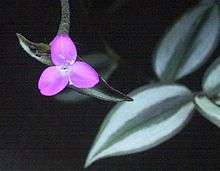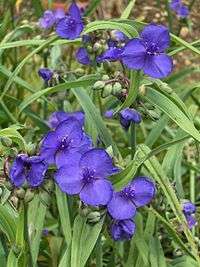Tradescantia
| Tradescantia | |
|---|---|
| | |
| Tradescantia virginiana | |
| Scientific classification | |
| Kingdom: | Plantae |
| (unranked): | Angiosperms |
| (unranked): | Monocots |
| (unranked): | Commelinids |
| Order: | Commelinales |
| Family: | Commelinaceae |
| Subfamily: | Commelinoideae |
| Tribe: | Tradescantieae |
| Subtribe: | Tradescantiinae |
| Genus: | Tradescantia Ruppius ex L.[1][2] |
| Type species | |
| Tradescantia virginiana L. | |
| Sections | |
|
Sections
| |
| Synonyms[2][3] | |
|
Synonyms
| |

Tradescantia /ˌtrædᵻˈskæntiə/,[4] the spiderworts,[5] is a genus of 75 species of herbaceous perennial plants in the family Commelinaceae, native to the New World from southern Canada south to northern Argentina including the West Indies. They were introduced into Europe as ornamental plants in the seventeenth century and are now grown as such in many parts of the world. Subsequently, some species have become naturalized in various regions of Europe, Asia, Africa, Australia and assorted oceanic islands.[3]
Tradescantia are weakly upright to scrambling plants, growing to 30–60 cm tall (0.98–1.97 ft), and are commonly found individually or in clumps in wooded areas and fields. A number of the species flower in the morning and when the sun shines on the flowers in the afternoon they close, but can remain open on cloudy days until evening. The three species of Wandering Jew, one native to eastern Mexico, also belong to the Tradescantia genus. Other names used for various species include spider-lily, cradle-lily, oyster-plant and flowering inch plant.
The genus is of interest to cytogenetics because of the evolutionary changes in the structure and number of their chromosomes. In addition to their use as ornamentals, the genus is of economic importance because a number of species have become pests to cultivated crops. They have also been used as bioindicators for the detection of environmental mutagens.
Description
Tradescantia are herbaceous perennials and include both climbing and trailing species, reaching 30–60 centimetres (0.98–1.97 ft) in height. The leaves are long, thin and blade-like to lanceolate, from 3–45 cm long (1.2–17.7 in). The flowers can be white, pink, or purple, but are most commonly bright blue, with three petals and six yellow anthers (or rarely, four petals and eight yellow anthers). The sap is mucilaginous and clear.
Taxonomy
Subdivision

(Austrotradescantia )
(Coholomia)

(Rhoeo)

(Setcreasea)
(Tradescantia: Virginianeae)
.jpg)
(Tradescantia: Sillamontanae)

(Zebrina)
In the 1980s David Hunt divided the genus into 8[6] (later 12)[7] sections, with the nominate section (Tradescantia) further subdivided into a further four series, this superseded an earlier system by Clarke (1881).[8] Hunt originally recognised 60 species of which over half (32) he placed in section Tradescantia. Hunt's original speciation is given here, as further circumscribed by Burns et al. (2011).[9] Enlarging the sections from eight to twelve added six further species (total 68). Within section Tradescantia he distinguished the American species (series Virginianae) from the three Mexican series (Tuberosae, Sillamontanae, Orchidophyllae). 'Type' here indicates Species typica. Numbering of sections refers to Hunt's original (1980) system as a cross check to his index. The renumbered sections from 1986 are given in italics, e.g. (1)(5).
Note 1: The place of T. schippii is uncertain. Hunt indicates it is included in section Zebrina, but Burns considers the section monotypic
Note 2: T. blossfeldiana as used by Hunt and Burns is now considered a synonym for T. cerinthoides. Hunt originally listed these as separate species. Hunt also listed T. potosina and T. nuevoleonensis as separate species, but the latter is now the accepted name, while T. subramosa and T. subtilis are now considered synonyms for T. maysillesii rather than separate species.[10]
(Brazil, Uruguay, N Argentina)
(Tropical America)
(Guatemala, El Salvador, S Mexico)
(S Mexico, Guatemala, Nicaragua and Costa Rica)
(Mexico to Bolivia and Brazil)
(Mexico: Durango)
(Mexico: Chihuahua to Oaxaca)
(Mexico (Yucatán), Belize)
(Mexico: Durango)
|
(U.S.A.: Texas; Mexico: Chihuahua to Veracruz)
(Mexico to Venezuela)
|
Nothospecies

- Tradescantia × andersoniana W.Ludw. & Rohweder [13][14] Phylogenetically T. x andersoniana is situated within series Virginianae, as follows ( T. ohiensis × ( T. subaspera Ker Gawl. × T. virginiana L.)).[9]
Formerly placed here
- Callisia navicularis (Ortgies) D.R.Hunt (as T. navicularis Ortgies)
- Callisia warszewicziana (Kunth & C.D.Bouché) D.R.Hunt (as T. warszewicziana Kunth & C.D.Bouché)
- Gibasis geniculata (Jacq.) Rohweder (as T. geniculata Jacq.)
- Gibasis karwinskyana (Schult. & Schult.f.) Rohweder (as T. karwinskyana Schult. & Schult.f.)
- Gibasis pellucida (M.Martens & Galeotti) D.R.Hunt (as T. pellucida M.Martens & Galeotti)
- Siderasis fuscata (Lodd. et al.) H.E.Moore (as T. fuscata Lodd. et al.)
- Tinantia anomala (Torr.) C.B.Clarke (as T. anomala Torr.)
- Tripogandra diuretica (Mart.) Handlos (as T. diuretica Mart.)[12]
Species
By 1998 Fadden listed 70 species,[15] while currently The Plant List accepts 75.[16]
Etymology
The name of the genus by Linnaeus honours the English naturalists and explorers John Tradescant the Elder (ca. 1570s – 1638) and John Tradescant the Younger (1608–1662).[17][18] They introduced many new plants to English gardens. Tradescant the Younger mounted three expeditions to the New World colony of Virginia.[19] From there Tradescantia virginiana, the type species, was brought to England in 1629.
The genus Tradescantia has received many common names, varying by region and country. Some of these names refer to the plants' great dispersal ability or invasiveness, such as "Wandering Jew". The latter refers to a Christian myth of the Wandering Jew, condemned to wander the earth for taunting Jesus on the way to his crucifixion.[20] In Spanish, it is sometimes referred to as "flor de Santa Lucía" (Saint Lucy's flower), in reference to the Saint's reputation as the patron saint of sight, and the use of the juice of the plant as eye drops to relieve congestion.[21]
Distribution and habitat
The first species described, Virginia Spiderwort T. virginiana, is native to the eastern United States from Maine to Alabama, and Canada in southern Ontario. Virginia Spiderwort was introduced to Europe in 1629, where it is cultivated as a garden flower.
Conservation
The Western Spiderwort T. occidentalis is listed as an endangered species in Canada, where the northernmost populations of the species are found at a few sites in southern Saskatchewan, Manitoba and Alberta; it is however more common further south in the United States south to Texas and Arizona.
Cultivation
Though sometimes considered a weed, spiderwort is cultivated for borders and also used in containers. Where it appears as a volunteer, it is often welcomed and allowed to stay. Temperate species are grown as garden plants while tropical species such as T. zebrina and T. spathacea are used for house plants.[18]
A common cultivar group responsible for most commercially available plants is derived from the naturally occurring interspecific hybrid (nothospecies) Tradescantia × andersoniana, an invalid name more correctly referred to as 'Andersoniana Group' since it includes several cultivars, the origins of which are complex.[22] The group were derived from naturally occurring cross-pollination between Tradescantia virginiana, T. ohiensis, and T. subaspera in overlapping ranges within continental North America.[18] They share a number of characteristics, although differing in flower colour.[23] The cultivars in this group include 'Blue Stone', 'Isis', 'Innocence', 'Snowcap', 'Osprey', 'Iris Pritchard', 'Pauline', 'Red Cloud' and 'Karminglut' ('Carmine Glow').[24][18] Tradescantia × andersoniana var. caerulea plena is a double flowered variety with dark blue flowers.[22][23]
Toxicity
Some members of the genus Tradescantia may cause allergic reactions in pets (especially cats and dogs), characterised by red, itchy skin. Notable culprits include T. albiflora (Scurvy Weed); T. spathacea (Moses In The Cradle); and T. pallida (Purple Heart).
Uses

The American Indians used T. virginiana to treat a number of conditions, including stomach ache and cancer. it was also used as a food source.[18] The cells of the stamen hairs of some Tradescantia are colored blue, but when exposed to sources of ionizing radiation such as gamma rays, the cells mutate and change color to pink; they are one of the few tissues known to serve as an effective bioassay for ambient radiation levels.[25][18]
References
- ↑ Linnaeus Sp. Pl.: 288 (1753).
- 1 2 "Genus: Tradescantia L.". Germplasm Resources Information Network. United States Department of Agriculture. 2004-08-10. Retrieved 2011-03-20.
- 1 2 Kew World Checklist of Selected Plant Families
- ↑ Sunset Western Garden Book, 1995:606–607
- ↑ "Tradescantia". Natural Resources Conservation Service PLANTS Database. USDA. Retrieved 14 December 2015.
- 1 2 Hunt, David R. (1980). "Sections and Series in Tradescantia: American Commelinaceae: IX". Kew Bulletin. 35 (2): 437–442. doi:10.2307/4114596. JSTOR 4114596.
- 1 2 Hunt, David R. (1986). "Campelia, Rhoeo and Zebrina united with Tradescantia: American Commelinaceae: XIII". Kew Bulletin. 41 (2): 401–405. doi:10.2307/4102948. JSTOR 4102948.
- ↑ C B Clarke Commelinaceae. In A. & C. De Candolle Monogr. Phan. 3: 288, 113-324 (1881).
- 1 2 Burns, Jean H.; Faden, Robert B.; Steppan, Scott J. (2011). "Phylogenetic Studies in the Commelinaceae Subfamily Commelinoideae Inferred from Nuclear Ribosomal and Chloroplast DNA Sequences". Systematic Botany. 36 (2): 268–276. doi:10.1600/036364411X569471.
- ↑ World Checklist of Selected Plant Families
- ↑ "Tradescantia". Integrated Taxonomic Information System. Retrieved 2011-06-16.
- 1 2 "GRIN Species Records of Tradescantia". Germplasm Resources Information Network. United States Department of Agriculture. Retrieved 2011-06-16.
- ↑ Feddes Repert. Spec. Nov. Regni Veg. 56: 282 (1954)
- ↑ World Checklist
- ↑ Faden, R. B. (1998-01-01). Kubitzki, Professor Dr Klaus, ed. Commelinaceae. The Families and Genera of Vascular Plants. Springer Berlin Heidelberg. pp. 109–128. doi:10.1007/978-3-662-03531-3_12. ISBN 978-3-642-08378-5.
- ↑ The Plant List
- ↑ Quattrocchi, Umberto (2000). CRC World Dictionary of Plant Names: Common Names, Scientific Names, Eponyms, Synonyms, and Etymology. IV R-Z. Taylor & Francis US. p. 2697. ISBN 978-0-8493-2678-3.
- 1 2 3 4 5 6 Hawke 2010.
- ↑ José Manuel Sánchez de Lorenzo-Cáceres. Las especies del género Tradescantia cultivadas en España. 2004.
- ↑ Anderson, George K. The Legend of the Wandering Jew. Providence: Brown University Press, 1965. xi, 489 p.; ISBN 0-87451-547-5
- ↑ Bugatti, C.L. 2008. Desde el jardín. Esos yuyos con aire lujoso. La Nación (Argentina).
- 1 2 Dave's Garden 2015, Tod Boland. Spiderwort Hybrids - Tradescantia X andersoniana. September 1, 2012.
- 1 2 Christman 2005.
- ↑ Dave's Garden 2015, Spiderwort, Virginia Spiderwort, Lady's Tears Tradescantia x andersoniana 'Karminglut'.
- ↑ Ichikawa, Sadao (1972). "Somatic Mutation Rate in Tradescantia Stamen Hairs at Low Radiation Levels: Finding of Low Doubling Doses of Mutations". The Japanese Journal of Genetics. 47 (6): 411–421. doi:10.1266/jjg.47.411.
Bibliography
- Christman, Steve (10 March 2005). "Tradescantia Andersoniana Group". Floridata Plant Encyclopedia. Retrieved 13 June 2015.
- Dave's Garden (2015). "Welcome to Dave's Garden!". Internet Brands. Retrieved 14 June 2015.
- Hawke, Richard G. (2010). "A Comparative Study of Tradescantia Cultivars" (PDF). Plant Evaluation Notes (34): 1–9. Retrieved 14 June 2015.
- Beal, Janet. "Common Names for Tradescantia Flowers". SFGate. Retrieved 14 June 2015.
- Edgar, Anderson; Karl, Sax (March 1936). "A Cytological Monograph of the American Species of Tradescantia". Botanical Gazette. 97 (3): 433–476. doi:10.1086/334582. JSTOR 2471708.
Gallery
-

Front view of leaves of Tradescantia pallida cv. "Purple Heart".
-

Back view of leaves of Tradescantia pallida cv. "Purple Heart".
-

Front view of leaves of Tradescantia zebrina cv. "Tricolor".
-

Back view of leaves of Tradescantia zebrina cv. "Tricolor".
-

A budding Tradescantia flower
-

Tradescantia cv. "Red Grape".
External links
- Flora of North America: Tradescantia (includes species in USA and Canada only)
- PlantSystematics: Tradescantia
- Western Spiderwort endangered in Canada
| Wikisource has the text of the 1920 Encyclopedia Americana article Spiderwort. |
| Wikimedia Commons has media related to Tradescantia. |
| Wikispecies has information related to: Tradescantia |
| Look up tradescantia in Wiktionary, the free dictionary. |